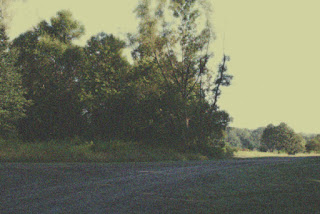 |
| Late Afternoon Reflections, pastel, 12x9 |
 |
| reference photo |
I went back and forth with how detailed to make the water ripples, as well as how hard and soft to make the edges. My distant trees seemed to be working with fairly soft edges, so I decided to keep the edges in the water mostly soft, except for a few areas that needed emphasis.
Regarding color (also part of my issue last week), I had to search for a way to handle the warm, peach highlights in the dark reflections in the water. I finally decided to interpret those warm highlights as more of a soft-edge glow rather than with linear strokes. This helped to give that upper right section of the painting an overall glow with it being placed near the warm, sunlit areas of the land and tree mass.
Still not being completely satisfied with this "problem painting," I thought the composition could be better...sooooooo...
 |
| Late Afternoon Reflections, pastel, 8x8 |














